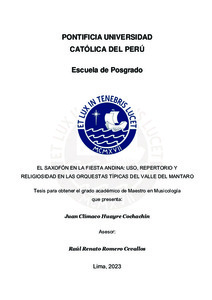| dc.contributor.advisor | Romero Cevallos, Raúl Renato | |
| dc.contributor.author | Huayre Cochachin, Juan Clímaco | |
| dc.date.accessioned | 2024-01-26T16:51:58Z | |
| dc.date.available | 2024-01-26T16:51:58Z | |
| dc.date.created | 2023 | |
| dc.date.issued | 2024-01-26 | |
| dc.identifier.uri | http://hdl.handle.net/20.500.12404/26961 | |
| dc.description.abstract | La fiesta andina es un espacio donde convergen una mezcla de tradiciones ancestrales y
contemporáneas, reflejando la cosmovisión andina y su estrecha relación con la naturaleza y el
universo. En este contexto, la música desempeña un papel fundamental y se transmite a través de una
gran diversidad de agrupaciones u organizaciones musicales que han surgido en el mundo andino a lo
largo del tiempo. A inicios del siglo XX, en el centro del Perú, emergió la orquesta típica, una de las
agrupaciones más representativas del valle del Mantaro. A medida que se desarrollaba, experimentó
cambios significativos debido a la asimilación de distintos instrumentos, siendo el saxofón el de mayor
preponderancia. Este instrumento ha tenido tanto arraigo en la región que, con el transcurrir del tiempo,
se ha convertido en un símbolo, tanto musical como visual. La presente tesis tiene como objetivo
investigar el uso del saxofón en las prácticas musicales de las orquestas típicas del valle del Mantaro
en el contexto de la fiesta andina. Se analizará cómo la asimilación de este instrumento ha producido
cambios en la instrumentación, el repertorio y ha generado una manera particular de interpretación.
Asimismo, se reflexionará sobre la participación del saxofón en la religiosidad y en la recreación de
una identidad musical en las orquestas típicas y, por ende, en la población del valle del Mantaro. La
metodología utilizada para este trabajo se centrará en gran medida en la observación participante,
enfocándose en el uso musical de los distintos tipos de saxofones, el repertorio, la religiosidad y otros
tópicos relacionados a las orquestas típicas. | es_ES |
| dc.description.abstract | The Andean celebration is a space where a blend of ancestral and contemporary traditions converge,
reflecting the Andean worldview and its close relationship with nature and the universe. In this context,
music plays a fundamental role and is transmitted through a wide variety of musical groups or
organizations that have emerged in the Andean world over time. At the beginning of the 20th century,
in central Peru, the typical orchestra emerged, one of the most representative groups in the Mantaro
Valley. As it developed, it underwent significant changes due to the assimilation of various
instruments, with the saxophone being the most prominent. This instrument has become so deeply
rooted in the region that, over time, it has become a symbol, both musically and visually. The purpose
of this thesis is to investigate the use of the saxophone in the musical practices of typical orchestras in
the Mantaro Valley within the context of the Andean celebration. It will analyze how the assimilation
of this instrument has produced changes in instrumentation, repertoire, and has generated a particular
way of interpretation. Likewise, it will reflect on the saxophone's role in religiosity and in the recreation
of a musical identity in typical orchestras, and therefore, in the population of the Mantaro Valley. The
methodology used for this work will focus largely on participant observation, with a focus on the
musical use of different types of saxophones, repertoire, religiosity, and other topics related to typical
orchestras. | es_ES |
| dc.language.iso | spa | es_ES |
| dc.publisher | Pontificia Universidad Católica del Perú | es_ES |
| dc.rights | info:eu-repo/semantics/openAccess | es_ES |
| dc.rights.uri | http://creativecommons.org/licenses/by-nc/2.5/pe/ | * |
| dc.subject | Música folklórica--Perú--Mantaro, Valle | es_ES |
| dc.subject | Saxofón | es_ES |
| dc.subject | Instrumentos de viento | es_ES |
| dc.subject | Grupos musicales--Perú--Mantaro, Valle | es_ES |
| dc.subject | Fiestas populares--Perú--Mantaro, Valle | es_ES |
| dc.title | El saxofón en la fiesta andina: uso, repertorio y religiosidad en las orquestas típicas del valle del Mantaro | es_ES |
| dc.type | info:eu-repo/semantics/masterThesis | es_ES |
| thesis.degree.name | Maestro en Musicología | es_ES |
| thesis.degree.level | Maestría | es_ES |
| thesis.degree.grantor | Pontificia Universidad Católica del Perú. Escuela de Posgrado. | es_ES |
| thesis.degree.discipline | Musicología | es_ES |
| renati.advisor.dni | 08234505 | |
| renati.advisor.orcid | https://orcid.org/0000-0002-4572-3865 | es_ES |
| renati.author.dni | 41649815 | |
| renati.discipline | 215067 | es_ES |
| renati.juror | Sadovnic Morán, Alter | es_ES |
| renati.juror | Romero Cevallos, Raúl Renato | es_ES |
| renati.juror | Huerta Mercado Tenorio, Víctor Alexander | es_ES |
| renati.level | https://purl.org/pe-repo/renati/level#maestro | es_ES |
| renati.type | https://purl.org/pe-repo/renati/type#tesis | es_ES |
| dc.publisher.country | PE | es_ES |
| dc.subject.ocde | https://purl.org/pe-repo/ocde/ford#6.04.04 | es_ES |







